Owner Maintenance
Owner Maintenance Precautions
The owner or a qualified service technician should make these vehicle inspections at the indicated intervals to ensure safe and dependable operation.
Bring any problem to the attention of an Authorized Mazda Dealer or qualified service technician as soon as possible.
When Refueling
-
Brake fluid level (Search)
-
Engine coolant level (Search)
-
Engine oil level (Search)
-
Washer fluid level (Search)
At Least Monthly
-
Tire inflation pressures (Search)
At Least Twice a Year (For Example, Every Spring and Fall)
You can do the following scheduled maintenance items if you have some mechanical ability and a few basic tools and if you closely follow the directions in this manual.
Improper or incomplete service may result in problems. This section gives instructions only for items that are easy to perform.
As explained in the Introduction (Search), several procedures can be done only by a qualified service technician with special tools.
Improper owner maintenance during the warranty period may affect warranty coverage. Refer to Introduction (Search) for owner's responsibility in protecting your investment. For details, read the separate Mazda Warranty statement provided with the vehicle. If you are unsure about any servicing or maintenance procedure, have it done by an Authorized Mazda Dealer.
There are strict environmental laws regarding the disposal of waste oil and fluids. Please dispose of your waste properly and with due regard to the environment.
We recommend that you entrust the oil and fluid changes of your vehicle to an Authorized Mazda Dealer.
Do not perform maintenance work if you lack sufficient knowledge and experience or the proper tools and equipment to do the work. Have maintenance work done by a qualified technician:
Performing maintenance work on a vehicle is dangerous if not done properly. You can be seriously injured while performing some maintenance procedures.
If you must run the engine while working under the hood, make certain that you remove all jewelry (especially rings, bracelets, watches, and necklaces) and all neckties, scarves, and similar loose clothing before getting near the engine or cooling fan which may turn on unexpectedly:
Working under the hood with the engine running is dangerous. It becomes even more dangerous when you wear jewelry, loose clothing or have long hair or a long beard.
Either can become entangled in moving parts and result in injury.
 Pull over to a safe location, then switch the ignition off and make sure the fan is not running before attempting to work near the cooling fan:
Pull over to a safe location, then switch the ignition off and make sure the fan is not running before attempting to work near the cooling fan:
Working near the cooling fan when it is running is dangerous. The fan could continue running indefinitely even if the engine has stopped and the engine compartment temperature is high. You could be hit by the fan and seriously injured.
Do not leave items in the engine compartment:
After you have finished checking or doing servicing in the engine compartment, do not forget and leave items such as tools or rags in the engine compartment.
Tools or other items left in the engine compartment could cause engine damage or a fire leading to an unexpected accident.
Hood
Always check that the hood is closed and securely locked:
A hood that is not closed and securely locked is dangerous as it could fly open while the vehicle is moving and block the driver's vision which could result in a serious accident.
Opening the Hood
-
With the vehicle parked, pull the release handle to unlock the hood.

-
Insert your hand into the hood opening, slide the latch lever to the right, and lift up the hood.
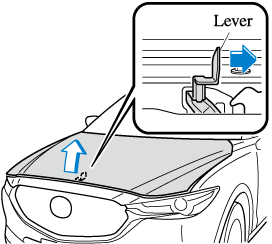
-
Grasp the support rod in the padded area and secure it in the support rod hole indicated by the arrow to hold the hood open.

Closing the Hood
-
Check under the hood area to make certain all filler caps are in place and all loose items (e.g. tools, oil containers, etc.) have been removed.
-
Lift the hood, grasp the padded area on the support rod, and secure the support rod in the clip. Verify that the support rod is secured in the clip before closing the hood.

-
Lower the hood slowly to a height of about 20 cm (7.9 in) above its closed position and then let it drop.
When closing the hood, do not push it excessively such as by applying your weight. Otherwise, the hood could be deformed.
Engine Compartment Overview
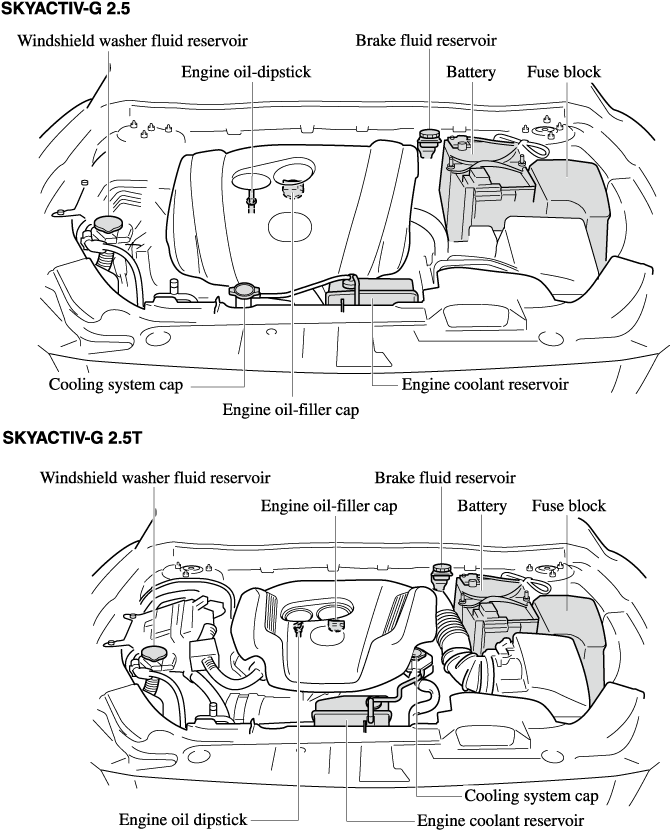
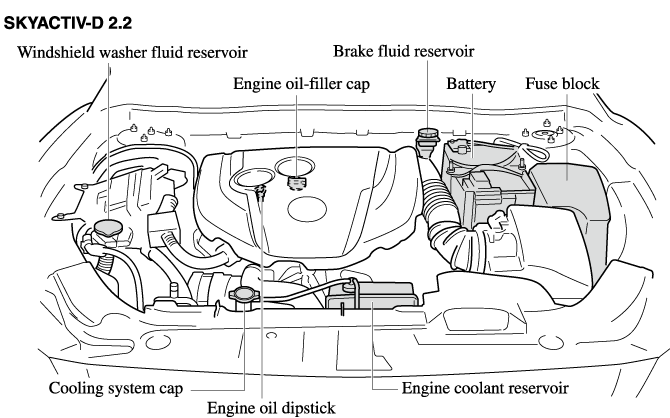
Engine Oil
Changing the engine oil should be performed by an Authorized Mazda Dealer.
Refer to Introduction (Search) for owner's responsibility in protecting your investment.
Recommended Oil
U.S.A., Canada
SKYACTIV-G 2.5
Use SAE 0W-20 engine oil.
Mazda Genuine Oil is used in your Mazda vehicle. Mazda Genuine 0W-20 Oil is required to achieve optimum fuel economy.
For maintenance service, Mazda recommends Mazda Genuine Parts and Oil.
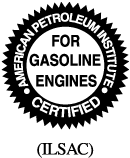
Only use SAE 0W-20 oil “Certified For Gasoline Engines” by the American Petroleum Institute (API).
Oil with this trademark symbol conforms to the current engine and emission system protection standards and fuel economy requirements of the International Lubricant Standardization and Approval Committee (ILSAC), comprised of U.S. and Japanese automobile manufacturers.
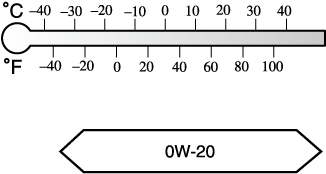
SKYACTIV-G 2.5T
Use SAE 5W-30 engine oil.
Mazda Genuine Oil is used in your Mazda vehicle. Mazda Genuine 5W-30 Oil is required to achieve optimum fuel economy.
For maintenance service, Mazda recommends Mazda Genuine Parts and Oil.
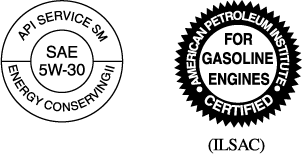
Only use SAE 5W-30 oil “Certified For Gasoline Engines” by the American Petroleum Institute (API).
Oil with this trademark symbol conforms to the current engine and emission system protection standards and fuel economy requirements of the International Lubricant Standardization and Approval Committee (ILSAC), comprised of U.S. and Japanese automobile manufacturers.
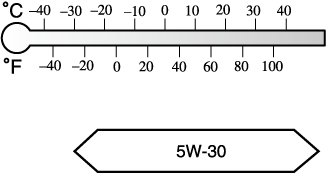
SKYACTIV-D 2.2
Mazda Genuine Oil is used in your Mazda vehicle and is the recommended SAE 0W-30 lubricant. Mazda Genuine SKYACTIV-D SAE 0W-30 Diesel Engine Oil is required to achieve optimum fuel economy and durability for the Diesel Particulate Filter. If Mazda Genuine SKYACTIV-D SAE 0W-30 Diesel Engine Oil is not available, an alternative oil specified below may be used for oil level maintenance and oil changes however, it is strongly recommended to replace the alternative oil with Mazda Genuine SKYACTIV-D SAE 0W-30 Diesel Engine Oil at the next oil change to maintain optimum performance.
Recommended oil: Mazda Genuine SKYACTIV-D SAE 0W-30 Diesel Engine Oil
Alternative oil: ACEA C3 and SAE 0W-30 or 5W-30
For maintenance service, Mazda recommends Mazda Genuine Part.
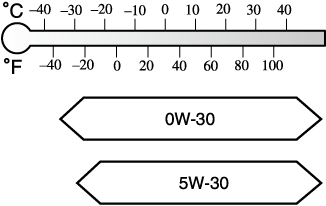
SKYACTIV-D 2.2 uses specified oil. Please confirm the specification in owner's manual. If engine oil other than the specified oil is used, the Diesel Particulate Filter effective period of use will be shortened or the Diesel Particulate Filter may be damaged.
Whenever the engine oil is replaced, the vehicles engine control unit needs to be reset as soon as possible. Otherwise, the engine oil warning light or the wrench indicator light may display at the wrong timing.
Refer to the Information section in the Mazda Connect Owner's Manual for the details.Except U.S.A., Canada
SKYACTIV-G 2.5
Use SAE 5W-30 engine oil.
Oil container labels provide important information.
A chief contribution this type of oil makes to fuel economy is reducing the amount of fuel necessary to overcome engine friction.
For maintenance service, Mazda recommends Mazda Genuine Parts.

(Mexico)

SKYACTIV-G 2.5
Use SAE 5W-30 engine oil. If SAE 5W-30 engine oil is not available, use SAE 5W-20 engine oil.
The quality designation SM or SN, or ILSAC must be on the label.
SKYACTIV-G 2.5T
Use SAE 5W-30 engine oil. If SAE 5W-30 engine oil is not available, use SAE 0W-30 or SAE 10W-30 engine oil.
The quality designation SM or SN, or ILSAC must be on the label.
Inspecting Engine Oil Level
-
Be sure the vehicle is on a level surface.
-
Warm up the engine to normal operating temperature.
-
Turn it off and wait at least 5 minutes for the oil to return to the oil pan.
-
Pull out the dipstick, wipe it clean, and reinsert it fully.
SKYACTIV-G 2.5 and SKYACTIV-G 2.5T

SKYACTIV-D 2.2

(SKYACTIV-D 2.2)
When inspecting the engine oil level, pull out the dipstick straight without twisting. In addition, when inserting the dipstick, always insert it without twisting so that the “X” mark faces the front of the vehicle.
-
Pull it out again and examine the level.
The level is normal if it is between the MIN and MAX marks.
If it is near or below MIN, add enough oil to bring the level to MAX.
-
Make sure the O-ring on the dipstick is positioned properly before reinserting the dipstick.
-
Reinsert the dipstick fully.
(SKYACTIV-D 2.2)
Inspect the engine oil level periodically. When inspecting the engine oil, if the engine oil level is exceeds the “X” mark on the dipstick, replace the engine oil. This should be done by an Authorized Mazda Dealer. When replacing the engine oil, inspect the oil level using the oil dipstick and refill so that the engine oil level is within the range between MIN and MAX as shown in the figure.

Brake Fluid
Inspecting Brake Fluid Level
If the brake fluid level is low, have the brakes inspected:
A low brake fluid level is dangerous.
A low level could indicate brake lining wear or a brake system leak which could cause the brakes to fail and lead to an accident.
Inspect the fluid level in the reservoir regularly. It should be kept between the MAX and MIN lines.
The level normally drops with accumulated distance, a condition associated with wear of brake linings. If it is excessively low, have the brake system inspected by an Authorized Mazda Dealer.

Washer Fluid
Inspecting Washer Fluid Level
Use only windshield washer fluid or plain water in the reservoir:
Using radiator antifreeze as washer fluid is dangerous. If sprayed on the windshield, it will dirty the windshield, affect your visibility, and could result in an accident.
Using Washer Fluid Without Anti-freeze Protection in Cold Weather:
Operating your vehicle in temperatures below 4 °C (40 °F) using washer fluid without anti-freeze protection is dangerous as it could cause impaired windshield vision and result in an accident. In cold weather, always use washer fluid with anti-freeze protection.
State or local regulations may restrict the use of volatile organic compounds (VOCs), which are commonly used as anti-freeze agents in washer fluid. A washer fluid with limited VOC content should be used only if it provides adequate freeze resistance for all regions and climates in which the vehicle will be operated.
Inspect fluid level in the washer fluid reservoir; add fluid if necessary.
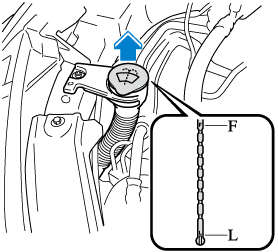
The top of the float should be between F and L.
Use plain water if washer fluid is unavailable.
But use only washer fluid in cold weather to prevent it from freezing.
Diesel Exhaust Fluid (DEF) (Some Models)
Diesel Exhaust Fluid (DEF) Handling
-
If DEF gets in your mouth, wash your mouth with a large amount of water immediately and seek medical attention. If DEF is mistakenly swallowed, drink 1 to 2 cups of water immediately and seek medical attention.
-
If DEF gets in your eyes, rinse them with running water immediately and seek medical attention.
-
Do not use DEF when 2 years have elapsed from the production date indicated on the container or the use period has expired. If DEF with an expired use period is used, the Selective Catalytic Reduction (SCR) System may not operate normally.
-
Do not store DEF in the vehicle. DEF may deteriorate or the interior may be damaged due to fluid leakage from the container.
-
If DEF gets on the painted surface or the interior, wash it off with water or wipe it off with a wet cloth immediately. Otherwise, it may damage the painted surface or the interior.
-
If DEF crystals form on the painted surface or the interior, wipe them off with a wet cloth. Otherwise, it may damage the painted surface or the interior.
-
Store DEF in a place out of the reach of children.
-
Do not put DEF into a different container. There may be foreign matter in the container. If DEF containing foreign matter is used, it could cause a problem with the SCR system. In addition, changing containers is dangerous because it increases the risk of accidental ingestion.
-
DEF is a colorless, transparent, odorless, and nonpoisonous solution (urea: 32.5 %, aqueous solution (AUS32)).
-
Store DEF in a cool, dark place.
-
DEF freezes at –11 °C (12 °F), however, when the temperature increases, the DEF returns to its original condition.
-
When opening the container, there may be a smell of ammonia. Open the container in a well-ventilated area.
-
If DEF gets on your hands, wash them with running water immediately.
Body Lubrication
All moving points of the body, such as door and hood hinges and locks, should be lubricated each time the engine oil is changed. Use a nonfreezing lubricant on locks during cold weather.
Make sure the hood's secondary latch keeps the hood from opening when the primary latch is released.
Wiper Blades
-
Hot waxes applied by automatic car washers have been known to affect the wiper's ability to clean windows.
-
To prevent damage to the wiper blades, do not use gasoline, kerosene, paint thinner, or other solvents on or near them.
-
When the wiper lever is in the AUTO position and the ignition is switched ON, the wipers may move automatically in the following cases:
-
If the windshield above the rain sensor is touched.
-
If the windshield above the rain sensor is wiped with a cloth.
-
If the windshield is struck with a hand or other object.
-
If the rain sensor is struck with a hand or other object from inside the vehicle.
Be careful not to pinch hands or fingers as it may cause injury, or damage the wipers. When washing or servicing the vehicle, make sure the wiper lever is in the OFF position.
-
Contamination of either the windshield or the blades with foreign matter can reduce wiper effectiveness. Common sources are insects, tree sap, and hot wax treatments used by some commercial car washes.
If the blades are not wiping properly, clean the window and blades with a good cleaner or mild detergent; then rinse thoroughly with clean water. Repeat if necessary.
Replacing Windshield Wiper Blades
Replacing Rear Window Wiper Blade
When the wiper no longer cleans well, the blade is probably worn or cracked.
Replace it.
To prevent damage to the wiper arm and other components, do not move the wiper by hand.
-
Remove the cover and raise the wiper arm.
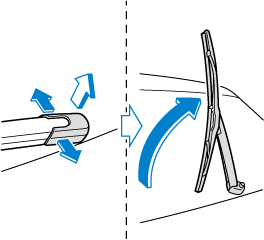
-
Firmly rotate the wiper blade to the right until it unlocks, then remove the blade.
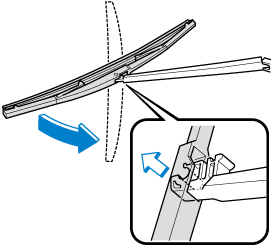
To prevent damage to the rear window, do not let the wiper arm fall on it.
-
Pull down the blade rubber and slide it out of the blade holder.
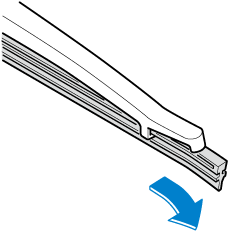
-
Remove the metal stiffeners from the blade rubber and install them in the new blade.
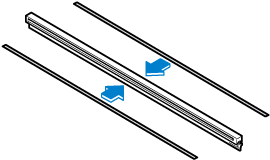
-
Carefully insert the new blade rubber.
Then install the blade assembly in the reverse order of removal.
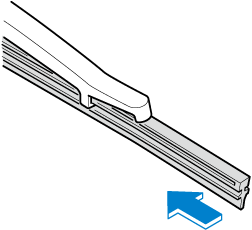
Battery
Wash hands after handling the battery and related accessories:
Battery posts, terminals and related accessories contain lead and lead compounds, chemicals known to the State of California to cause cancer and reproductive harm.
 Read the following precautions carefully before using the battery or inspecting to ensure safe and correct handling:
Read the following precautions carefully before using the battery or inspecting to ensure safe and correct handling:
 Always wear eye protection when working near the battery:
Always wear eye protection when working near the battery:
Working without eye protection is dangerous. Battery fluid contains SULFURIC ACID which could cause blindness if splashed into your eyes. Also, hydrogen gas produced during normal battery operation, could ignite and cause the battery to explode.
 Wear eye protection and protective gloves to prevent contact with battery fluid:
Wear eye protection and protective gloves to prevent contact with battery fluid:
Spilled battery fluid is dangerous.
Battery fluid contains SULFURIC ACID which could cause serious injuries if it gets in eyes, or on the skin or clothing. If this happens, immediately flush your eyes with water for 15 minutes or wash your skin thoroughly and get medical attention.
 Always keep batteries out of the reach of children:
Always keep batteries out of the reach of children:
Allowing children to play near batteries is dangerous. Battery fluid could cause serious injuries if it gets in the eyes or on the skin.
 Keep flames and sparks away from open battery cells and do not allow metal tools to contact the positive (
Keep flames and sparks away from open battery cells and do not allow metal tools to contact the positive ( ) or negative (
) or negative ( ) terminal of the battery when working near a battery. Do not allow the positive (
) terminal of the battery when working near a battery. Do not allow the positive ( ) terminal to contact the vehicle body:
) terminal to contact the vehicle body:
Flames and sparks near open battery cells are dangerous. Hydrogen gas, produced during normal battery operation, could ignite and cause the battery to explode. An exploding battery can cause serious burns and injuries. Keep all flames including cigarettes and sparks away from open battery cells.
 Keep all flames and sparks away from open battery cells because hydrogen gas is produced from open battery cells while charging the battery or adding battery fluid:
Keep all flames and sparks away from open battery cells because hydrogen gas is produced from open battery cells while charging the battery or adding battery fluid:
Flames and sparks near open battery cells are dangerous. Hydrogen gas, produced during normal battery operation, could ignite and cause the battery to explode. An exploding battery can cause serious burns and injuries. Keep all flames including cigarettes and sparks away from open battery cells.





























































